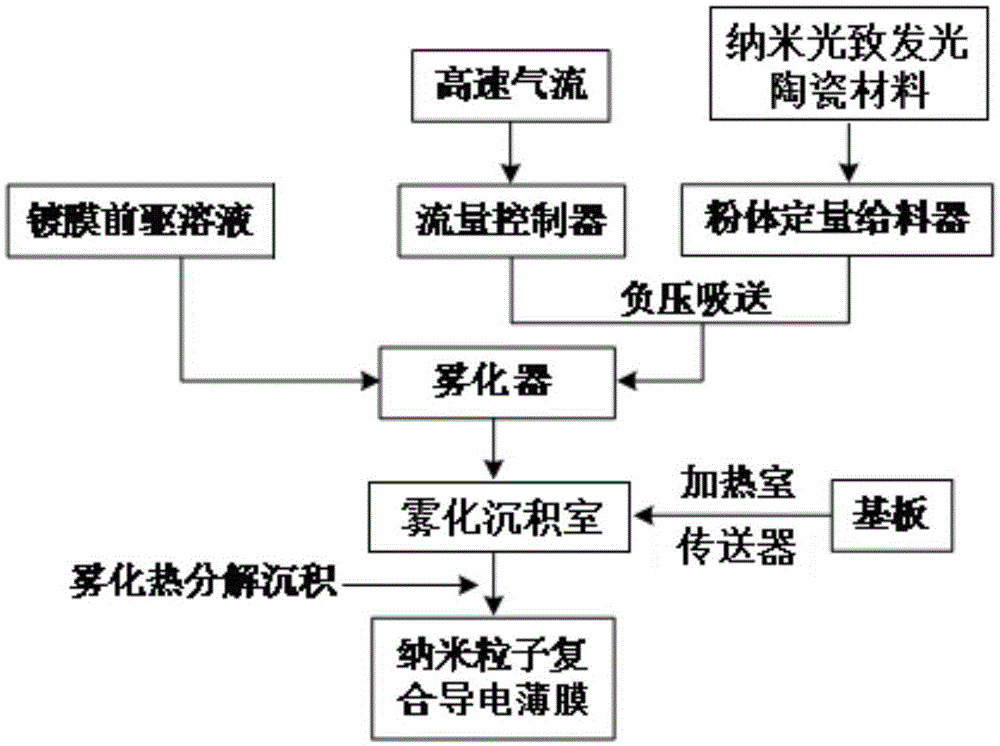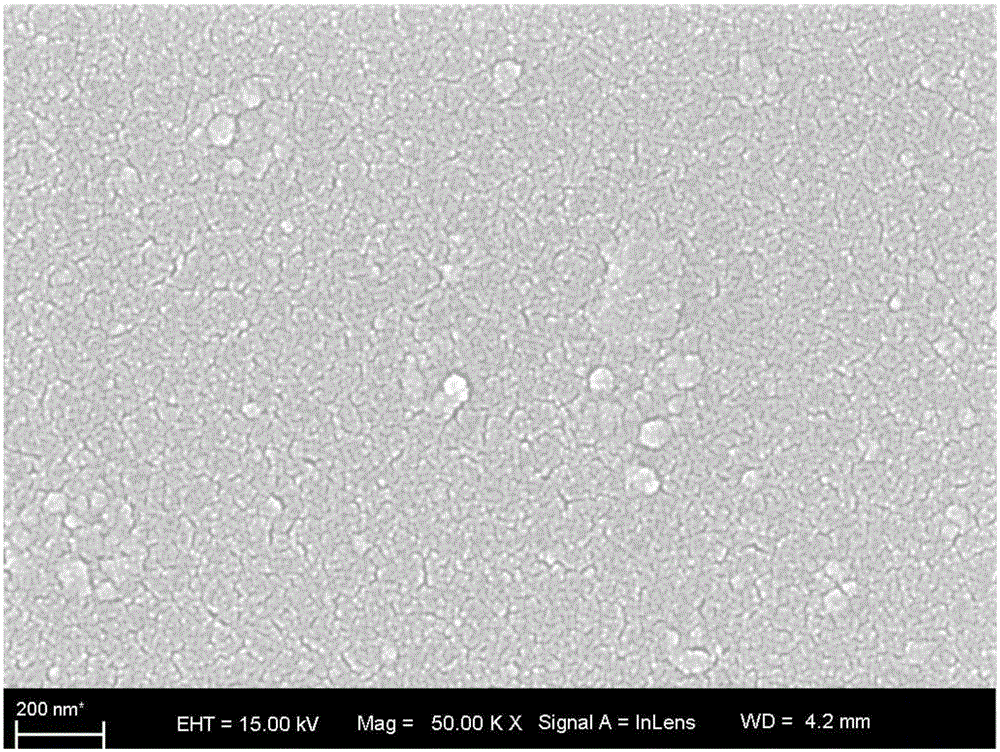Method for preparing nano-composite conductive thin film for photovoltaic cell
A nano-composite, conductive thin film technology, used in photovoltaic power generation, circuits, electrical components, etc., can solve the problems of limited anti-reflection effect of a single silicon oxide-based anti-reflection coating, surface electrostatic dust adsorption, etc., to achieve maintenance-free and Long-term operation, high transmittance, and the effect of improving photoelectric conversion efficiency and utilization rate
- Summary
- Abstract
- Description
- Claims
- Application Information
AI Technical Summary
Problems solved by technology
Method used
Image
Examples
Embodiment 1
[0049] Step 1, prepare deposition aerosol:
[0050] 1.1 Europium-doped vanadium phosphate nano ceramic powder (Eu:YP x V (1-x) o 4 , x=0.4~0.6, commercially available, 15nm~20nm) put into the powder quantitative feeder, control the feeding speed to 0.1g / min~0.22g / min, adopt high-speed airflow siphon negative pressure to make nano photoluminescence The ceramic material forms an atomized air flow, and the air flow rate is controlled to be 1L / min~1.5L / min;
[0051] 1.2 The atomizing airflow atomizes the ATO (antimony-doped tin oxide) solution (concentration: 10wt% to 12wt%) in the water system in the atomizer to form a deposition aerosol, which is passed into the atomization deposition chamber.
[0052] Step 2, nanoparticle composite film deposition:
[0053] Heat the ultra-clear glass substrate for photovoltaic cells to 480°C-500°C in the heating chamber, send it into the atomization deposition chamber through the conveyor, and deposit the deposition mist on the substrate fo...
Embodiment 2
[0055] Step 1, prepare deposition aerosol:
[0056] 1.1 Europium-doped yttrium vanadate nano ceramic powder (Eu:YVO 4 , commercially available, 30nm ~ 40nm) into the powder quantitative feeder, control the feeding speed of 1.8g / min ~ 2g / min, use the high-speed airflow siphon negative pressure to make the nano photoluminescent ceramic material form an atomized airflow, Control the flow rate of airflow to 6L / min~7L / min;
[0057] 1.2 The atomizing gas flow atomizes the FTO (fluorine-doped tin oxide) solution (concentration: 15wt%-20wt%) of the water system in the atomizer to form a deposition aerosol, which is passed into the atomization deposition chamber.
[0058] Step 2, nanoparticle composite film deposition:
[0059] Heat the ultra-white glass substrate for photovoltaic cells to 500°C-520°C in the heating chamber, and send it into the atomization deposition chamber through the conveyor, so that the deposition mist is deposited on the substrate for 5-10s, and a photovoltaic...
Embodiment 3
[0061] Step 1, prepare deposition aerosol:
[0062] 1.1 Europium-doped yttrium vanadate nano ceramic powder (Eu:YVO 4 , commercially available, 20nm ~ 30nm) into the powder quantitative feeder, control the feeding speed of 0.5g / min ~ 0.8g / min, use high-speed airflow siphon negative pressure to make the nano-photoluminescent ceramic material form an atomized airflow , control the air flow rate to 4L / min~5L / min;
[0063] 1.2 Atomizing air flow ATO (antimony-doped tin oxide) solution (concentration: 15wt%-17wt%) in isopropanol system is atomized in the atomizer to form deposition aerosol, which is passed into the atomization deposition chamber.
[0064] Step 2, nanoparticle composite film deposition:
[0065] Heat the ultra-clear glass substrate for photovoltaic cells to 640°C-650°C in the heating chamber, send it into the atomization deposition chamber through the conveyor, and deposit the deposition mist on the substrate for 18-20s to obtain a photovoltaic cell with a thickne...
PUM
| Property | Measurement | Unit |
|---|---|---|
| particle diameter | aaaaa | aaaaa |
| thickness | aaaaa | aaaaa |
| thickness | aaaaa | aaaaa |
Abstract
Description
Claims
Application Information
 Login to View More
Login to View More - R&D
- Intellectual Property
- Life Sciences
- Materials
- Tech Scout
- Unparalleled Data Quality
- Higher Quality Content
- 60% Fewer Hallucinations
Browse by: Latest US Patents, China's latest patents, Technical Efficacy Thesaurus, Application Domain, Technology Topic, Popular Technical Reports.
© 2025 PatSnap. All rights reserved.Legal|Privacy policy|Modern Slavery Act Transparency Statement|Sitemap|About US| Contact US: help@patsnap.com



